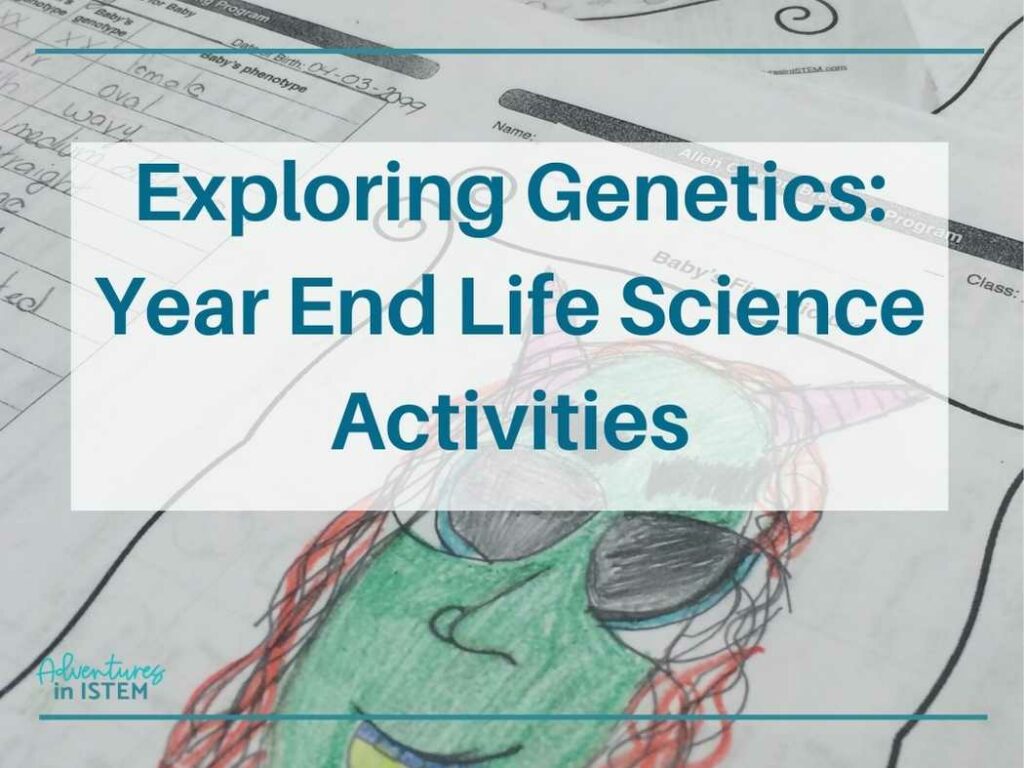Can you feel the excitement in the air? As the school year winds down, your students are eagerly anticipating the summer break ahead.
But with a month left to go and state testing out of the way, how do you keep their minds engaged and their enthusiasm for learning alive? Fear not! We’ve compiled a list of 24 captivating year end life science activities to wrap up the year with a bang.
These activities will review the topics they’ve learned, spark curiosity, and keep them actively engaged until the final bell rings.
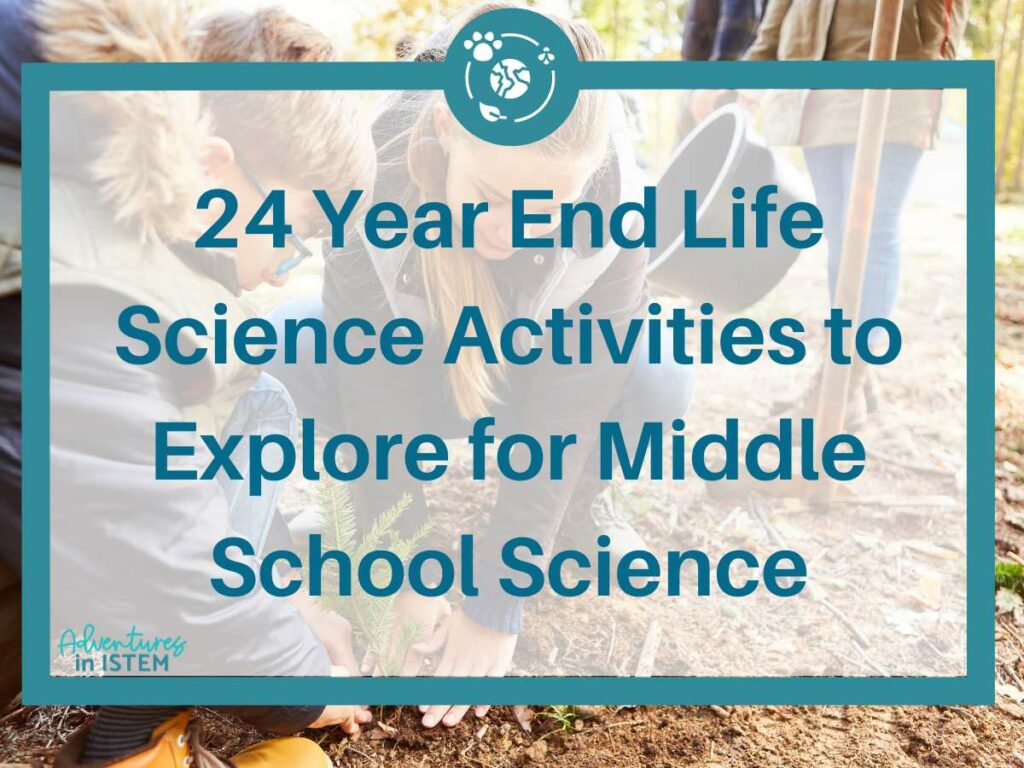
#1:Exploring Genetics: Year End Life Science Activities
In the realm of genetics, the end of the year is the perfect time for students to delve into captivating projects that bring genetic principles to life.
Here’s a lineup of engaging year end life science activities sure to ignite curiosity and deepen understanding:
- Punnett Square Build an Alien Challenge: Dive into the fascinating world of genetics with the Punnett Square Challenge! Encourage students to flex their genetic prediction muscles by creating an alien family using Punnett squares. Students will mix the traits of alien moms and dads to create their alien families. This is a fun activity to help them review genetics.
-
Genetic Traits Survey: Embark on a journey of genetic discovery by conducting a Genetic Traits Survey among classmates. Students can design questionnaires to gather data on various inherited traits within their peer group, ranging from physical characteristics like hair color and height to more nuanced traits such as taste preferences or susceptibility to certain allergies.
Once the data is collected, students can analyze the results to uncover patterns and correlations, providing valuable insights into the diversity of genetic traits within the population. This activity promotes teamwork and data analysis skills and highlights the richness of genetic variation in our communities. -
Genetic Engineering Debate: Stimulate critical thinking and ethical discourse with a thought-provoking discussion on genetic engineering. Explore the concept of genetic modification and its real-world applications, from genetically modified organisms (GMOs) in agriculture to gene editing technologies like CRISPR-Cas9.
Encourage students to delve into the ethical considerations surrounding genetic engineering, such as the potential risks and benefits, societal implications, and the importance of informed decision-making. Engage students in a lively classroom debate where they can voice their opinions, evaluate opposing viewpoints, and grapple with the complex ethical dilemmas inherent in genetic manipulation.
This activity enhances students' understanding of biotechnology and cultivates their ability to evaluate scientific advancements and their impact on society critically. - Project-Based Learning: Genetic Disorders Research Project: Using a site like GARD, “Genetic and Rare Diseases Information Center,” students can dive deep into the intricate world of genetic disorders. They can choose a specific disorder and craft an informative presentation, shedding light on its causes, symptoms, and potential treatments. GARD provides a wealth of information on genetic and rare diseases, offering students a comprehensive platform to enhance their research and broaden their understanding.
- STEM Activity: DNA Extraction Experiment: The "DNA Extraction Lab" by Genetic Science Learning Center takes learning to the next level with their online lab. Guided by expert instruction from the University of Utah's Genetic Science Learning Center, students will embark on a virtual exploration of DNA extraction, gaining valuable insights into the techniques and technologies that drive genetic research forward.
With these end-of-year projects, students will deepen their understanding of genetics and cultivate a lifelong passion for scientific inquiry.
#2:Ecosystem Explorations: Year End Life Science Activities
Engaging students in ecosystem activities ignites their interest in the natural world by offering hands-on experiences that deepen understanding and foster creativity. These year end life science activities encourage critical thinking, problem-solving, and collaboration, bridging classroom knowledge with real-world applications.
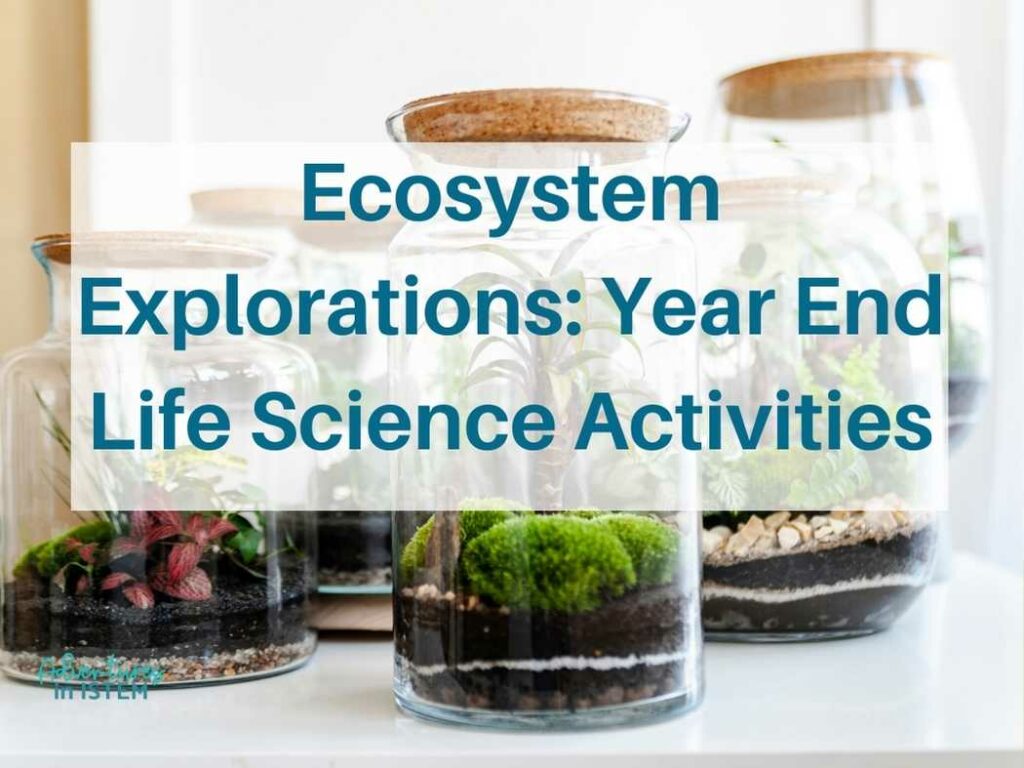
-
Mini Ecosystems: Guide students into creating their own mini ecosystems in jars. Encourage students to carefully select a variety of living organisms, such as plants, insects, and microorganisms, and arrange them in a sealed jar with soil or water.
Throughout the observation period, students can meticulously document changes in the ecosystem, noting interactions between organisms, nutrient cycling, and the effects of environmental factors like light and temperature.
By witnessing firsthand the delicate balance within these miniature worlds, students gain a deeper appreciation for the complexity and interconnectedness of natural systems. -
Food Web Simulation: Have students create a food web simulation. Students can construct food web diagrams, mapping out the complex interactions between producers, consumers, and decomposers. Through this hands-on activity, students gain insights into the interdependence of species within ecosystems and explore the ripple effects of population changes on food webs.
Encourage students to identify trophic levels, discuss predator-prey relationships, and predict the consequences of population fluctuations on the stability of the ecosystem. Students develop a holistic understanding of ecosystem dynamics and the delicate balance of nature by analyzing hypothetical scenarios and tracing energy flow through various trophic levels.
-
Ecological Field Trip: Take an ecological field trip to a local ecosystem. Whether it's a nearby forest, wetland, or shoreline, students can observe biodiversity up close, record observations, and engage in hands-on field investigations.
From identifying plant and animal species to analyzing abiotic factors such as soil composition and water quality, students gain valuable insights into ecosystems' intricate relationships. Through guided discussions and data collection activities, students deepen their understanding of ecological concepts and develop a profound connection to the natural world. -
Project-Based Learning: Ecological Impact Assessment Have students assess the ecological impact of a local construction project and propose solutions using "National Oceanic and Atmospheric Administration" (NOAA) Habitat Conservation. Students will take on the role of environmental scientists tasked with assessing the ecological impact of a local construction project.
They will begin by conducting thorough research on the proposed construction site, identifying its ecological significance, including any sensitive habitats or endangered species that may be impacted. They will utilize resources such as maps, field surveys, and environmental reports to gather relevant data.
Next, students will analyze the potential environmental consequences of the construction project, considering factors such as habitat destruction, water and air pollution, and disruption of wildlife corridors. Using their findings, students will brainstorm and propose innovative solutions to mitigate or minimize the project's ecological footprint.
These solutions include habitat restoration efforts, implementing green infrastructure practices, or advocating for alternative construction methods that prioritize environmental sustainability. To enhance their proposals, students will leverage resources provided by the National Oceanic and Atmospheric Administration (NOAA) Habitat Conservation program.
They will explore case studies, guidelines, and best practices for habitat conservation, drawing inspiration and guidance to inform their recommendations. Through collaborative discussions and peer feedback, students will refine their proposals, ensuring they are comprehensive, evidence-based, and aligned with principles of ecological stewardship. Ultimately, students will present their ecological impact assessments and proposed solutions to their peers, teachers, and relevant stakeholders, fostering critical thinking, communication skills, and environmental advocacy.
By engaging in this project, students deepen their understanding of ecological concepts and cultivate a sense of responsibility toward protecting and preserving our natural world. -
STEM Activity: Water Quality Testing Conduct water quality tests in a local water body and analyze the results using "EPA Water Quality Standards" by the U.S. Environmental Protection Agency. Students will become environmental scientists as they embark on a journey to assess the water quality of a local water body.
Beginning with an introduction to the importance of water quality and its impact on ecosystem health and human well-being, students will learn about the various parameters used to evaluate water quality, such as pH, dissolved oxygen, turbidity, and nutrient levels.
Equipped with water testing kits and sampling equipment, students will venture into the field to collect water samples from different points along the water body, including upstream, downstream, and potentially impacted areas near human activities or industrial sites.
Back in the classroom, students will conduct a series of tests on the water samples, following protocols outlined by the U.S. Environmental Protection Agency (EPA) Water Quality Standards. Using scientific instruments and analytical techniques, students will measure and analyze the data gathered from their water quality tests, comparing the results to EPA standards and guidelines.
Through data interpretation and critical thinking, students will identify deviations from expected water quality parameters and assess the potential implications for aquatic ecosystems and human health. In addition to analyzing water quality data, students will explore the factors influencing water quality, such as land use practices, pollution sources, and natural processes.
They will brainstorm strategies for addressing water quality issues and discuss the role of environmental stewardship in preserving freshwater resources for future generations.
Finally, students will communicate their findings and recommendations through presentations, reports, or multimedia projects, sharing their insights with classmates, teachers, and community members.
By engaging in this STEM activity, students develop essential scientific skills, including data collection, analysis, and interpretation, while also gaining a deeper understanding of environmental issues and the importance of sustainable water management practices.
#3:Biodiversity Bonanza: Year End Life Science Activities
These biodiversity year end life science activities immerse students in scientific exploration, fostering curiosity and deepening their understanding of the natural world. From uncovering ancient life forms to simulating evolutionary processes, students are empowered to explore the intricacies of evolution in innovative ways.
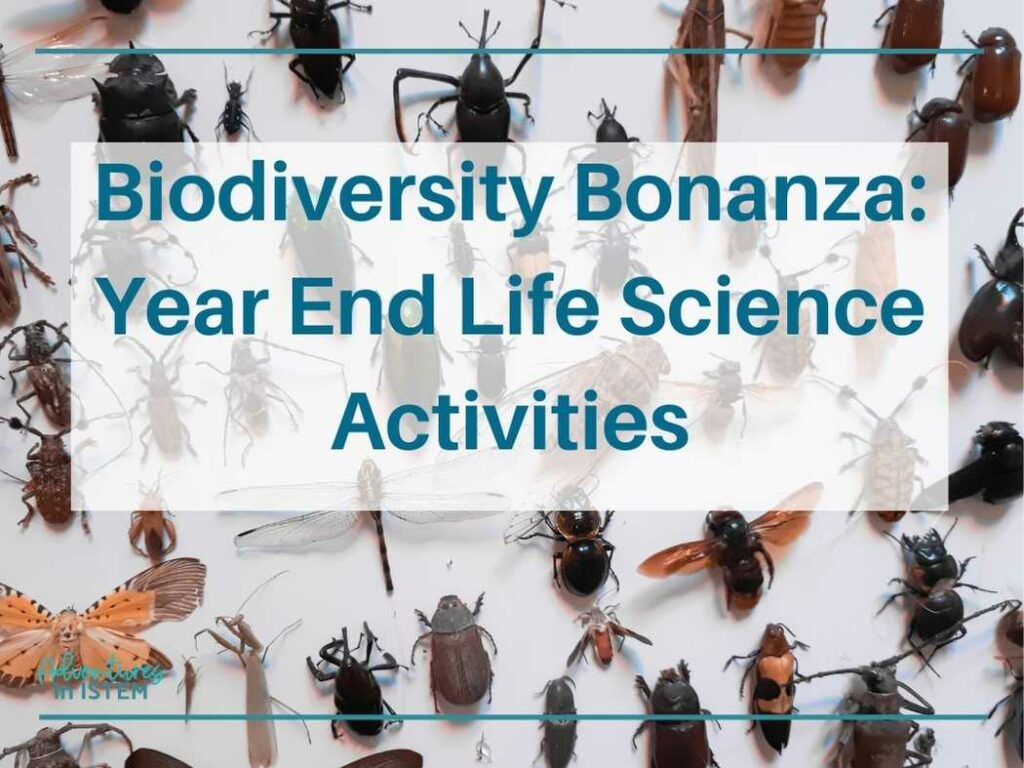
-
Biodiversity Surveys: This activity immerses students in the exploration of biodiversity by empowering them to become citizen scientists. Through hands-on fieldwork, students will develop observational skills and scientific inquiry as they document species diversity in their local environment.
Begin by guiding students in planning their biodiversity surveys. Discuss survey methods, such as transect sampling or quadrat sampling, and emphasize the importance of systematic data collection.
Accompany students on field trips to their schoolyard or a nearby natural area, providing guidance as they conduct surveys. Students will observe and record species diversity, documenting plants, animals, and other organisms they encounter.
Back in the classroom, facilitate data analysis activities where students organize and analyze their survey data. Based on their findings, encourage students to calculate species richness, diversity indices, and ecological patterns.
Conclude the activity with a reflection session where students discuss their observations, insights, and questions about biodiversity.
Encourage students to consider the significance of their findings and how they contribute to our understanding of local ecosystems. -
Insect Collection: Insect collection provides students with a hands-on opportunity to explore biodiversity up close while learning proper specimen collection and preservation techniques.
Begin by introducing students to the importance of insect diversity and the methods used in insect collection. Demonstrate appropriate techniques for capturing, handling, and preserving insect specimens.
Take students on a field excursion to collect insects from various habitats, such as grasslands, forests, or wetlands. Provide students with collecting equipment, such as nets, vials, and killing jars, and supervise their collection activities.
Instruct students on properly preserving insect specimens using techniques such as pinning or mounting. Provide guidance as students prepare their specimens for display and labeling. If you plan on releasing the insect afterward, you can skip this step and instead have them research proper care for the insect and ensure they release it within a short time.
Conclude the activity with a presentation session where students showcase their insect collections. Encourage students to discuss the diversity of insects they collected, their ecological roles, and any interesting observations or discoveries. -
Biodiversity Conservation Campaign: This activity empowers students to become advocates for biodiversity conservation by researching and proposing conservation measures to protect local species and ecosystems.
Guide students in researching local species, ecosystems, and conservation challenges. Provide resources such as scientific articles, government reports, and conservation organizations' websites to support their research. Encourage students to develop conservation proposals outlining specific measures to protect local biodiversity.
Students can explore habitat restoration, species reintroduction, community education, and policy advocacy strategies. Facilitate discussions on effective communication and advocacy strategies for promoting biodiversity conservation.
Encourage students to plan outreach activities, such as presentations, workshops, social media campaigns, or letter-writing campaigns, to raise awareness and mobilize support for their conservation proposals.
Conclude the activity with a presentation session where students present their conservation proposals to their peers, teachers, and community members. Encourage students to articulate the importance of biodiversity conservation, the rationale behind their proposals, and the potential impact of their initiatives. -
Project-Based Learning: Biodiversity Scavenger Hunt Organize a virtual biodiversity scavenger hunt where students identify local flora and fauna using the "iNaturalist" Citizen Science Project Website. The Biodiversity Scavenger Hunt combines technology with outdoor exploration, engaging students in an interactive quest to identify and document local flora and fauna.
Through this project, students will develop observation skills, species identification abilities, and scientific inquiry while contributing valuable data to citizen science efforts. Introduce students to the iNaturalist Citizen Science Project, emphasizing its role in biodiversity research and conservation.
Provide guidance on using the iNaturalist app or website to record observations and contribute to global biodiversity databases. Collaborate with students to plan the scavenger hunt, selecting target species and locations for observation. Encourage students to research local biodiversity and identify target organisms they hope to encounter during the scavenger hunt.
Organize a field trip or series of outdoor excursions where students explore designated areas and document their observations using the iNaturalist app. Students will work in teams or individually to identify and photograph species, recording relevant data such as location, habitat, and behavior.
Back in the classroom, facilitate data analysis activities where students review and analyze their observations on iNaturalist. Encourage students to explore trends, patterns, and species interactions within their datasets. Emphasize the importance of contributing data to citizen science projects and the broader scientific community.
Conclude the project with a reflection session where students discuss their scavenger hunt experiences, share notable observations, and reflect on the significance of their contributions to biodiversity research. Encourage students to share their findings with their peers and the school community -
Students create dioramas representing various biomes using UC Berkleys world biomes information. The Biome Diorama STEM activity provides students with a hands-on opportunity to explore global biodiversity and biome diversity through creative expression.
Students will deepen their understanding of ecological concepts by constructing dioramas representing various biomes while honing their artistic and design skills. Assign students to research different biomes, such as tropical rainforests, deserts, grasslands, or tundras.
Provide resources such as textbooks, websites, and multimedia materials to support their research. Encourage students to explore each biome's unique characteristics, climate patterns, flora, fauna, and adaptations.
Guide students in designing and planning their biome dioramas, considering factors such as scale, materials, and artistic elements. Encourage students to incorporate accurate representations of biome features, including vegetation, terrain, wildlife, and environmental factors such as precipitation and temperature.
Provide students with materials such as cardboard, paper, modeling clay, paint, and craft supplies to construct their biome dioramas. Support students as they bring their designs to life, offering guidance on construction techniques, artistic techniques, and attention to detail.
Conclude the activity with a presentation session where students showcase their biome dioramas to their peers, teachers, and community members. Encourage students to discuss the ecological characteristics of their chosen biomes, highlighting key features, biodiversity, and ecological interactions.
Foster discussion and peer feedback to promote understanding and appreciation of global biome diversity.
#4:Unraveling Evolution: Year End Life Science Activities
These hands-on evolution year end life science activities allow students to delve into ancient life forms, trace species’ evolutionary history, and simulate natural selection dynamics, fostering curiosity and deepening understanding of fundamental biological principles. Through interactive learning experiences, students gain insight into the interconnectedness of life and the processes shaping Earth’s biodiversity.
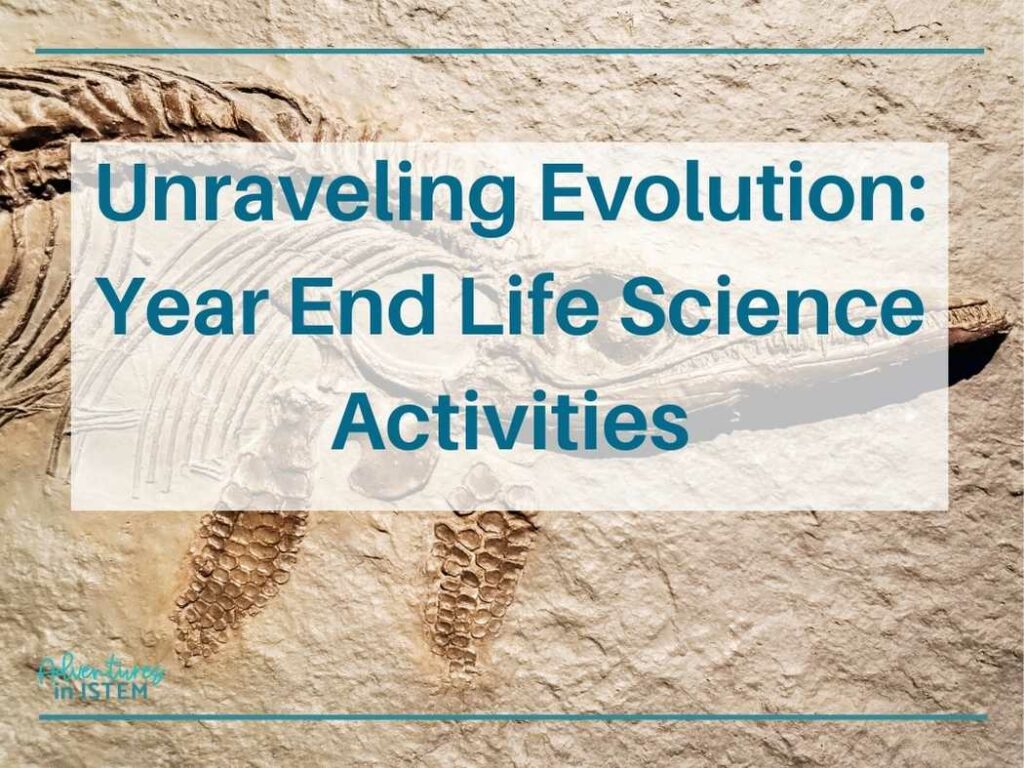
-
Fossil Analysis: Transport students back in time as they embark on a journey through the fossil record with the Fossil Analysis project. Provide students with fossil replicas representing various prehistoric organisms, from ancient marine creatures to long-extinct dinosaurs.
You might be able to borrow fossil kits from your local university like the University of Illinois does for educators. Encourage students to carefully examine these fossil specimens carefully, noting intricate details and discerning patterns of evolutionary change over millions of years.
This allows students to unravel the mysteries of the past, gaining insights into the diversity of life forms that have inhabited our planet throughout its history. -
Comparative Anatomy: Delve into the fascinating world of comparative anatomy as students uncover the underlying principles of homology—the study of anatomical similarities and differences across different species.
Provide students with skeletal specimens or anatomical models representing a variety of vertebrate animals, from mammals and birds to reptiles and amphibians. Again, check your local universities to see if you can borrow any specimens. Encourage students to carefully examine these structures, identifying shared anatomical features and elucidating evolutionary relationships.
This helps students develop a deeper appreciation for the unity of life and the evolutionary processes that have shaped the diversity of organisms on Earth. -
Evolutionary Timeline: Embark on a collaborative journey through the annals of time with the Evolutionary Timeline project. Task students with creating a visual timeline that traces the key milestones in the history of life on Earth, from the emergence of prokaryotic cells to the evolution of complex multicellular organisms.
Encourage students to research, gather evidence, and synthesize their findings into a cohesive narrative of evolutionary change. Students can gain a comprehensive understanding of the interconnectedness of life and the profound impact of evolutionary processes on shaping the biosphere with this activity -
Natural Selection Simulation: Immerse students in the dynamic process of natural selection with an engaging simulation designed to illustrate evolutionary principles in action.
Task students with designing and conducting a simulation that mimics the conditions of natural selection, allowing them to observe how heritable traits influence survival and reproduction within a population.
You can also have them use an online simulation like PhET's Natural Selection simulation. By manipulating variables such as environmental pressures and genetic variation, students gain firsthand experience in the mechanisms driving evolutionary change.
Through reflection and analysis, students deepen their understanding of natural selection and its role in shaping the diversity of life on Earth. -
Human Evolution Timeline: Trace the remarkable journey of human evolution with the Human Evolution Timeline project. Task students with exploring the evolutionary history of our species, from early hominids to modern Homo sapiens, and creating a visual timeline that highlights key developments along the way.
Through research and inquiry, students uncover the fossil evidence, genetic data, and archaeological findings that shed light on our evolutionary past. By synthesizing this information into a coherent narrative, students gain a deeper understanding of human ancestry and the processes that have shaped our species over millions of years. -
Project-Based Learning: Evolutionary Art Exhibition Students create artwork or exhibits that depict different stages of evolution using the "Tree of Life Web Project." Begin by guiding students through a research phase where they explore the Tree of Life Web Project.
Encourage students to investigate various branches of the tree, focusing on different taxa and evolutionary relationships. Students can select specific evolutionary milestones or transitions to serve as inspiration for their artwork.
Once students have gained insights into evolutionary patterns and relationships, facilitate the artistic creation process. Provide students with diverse artistic materials and mediums, such as drawing supplies, clay, digital design tools, or mixed media options. Students then translate their understanding of evolutionary concepts into visually engaging artworks or exhibits.
Encourage creativity and originality while ensuring that the artwork accurately reflects scientific principles. Conclude the project with a showcase of student artwork in an Evolutionary Art Exhibition. Invite peers, teachers, and parents to attend the exhibition, allowing students to share their creative interpretations of evolutionary themes.
Students can present their artwork during the exhibition and explain the evolutionary concepts depicted, fostering communication and public speaking skills. Evaluation of student work can be based on multiple criteria, including scientific accuracy, creativity, artistic technique, and presentation skills.
Provide feedback to students throughout the project to support their growth and development as scientists and artists. -
Adaptation Simulation: Use interactive online simulations to explore how organisms adapt to environmental changes using "Evolution Lab" by NOVA Labs.
Begin by introducing students to the concept of adaptation and its importance in evolutionary biology. Provide an overview of the Evolution Lab by NOVA Labs, highlighting its features and objectives. Discuss key concepts such as natural selection, genetic variation, and environmental factors that drive adaptation.
Guide students through the Evolution Lab, encouraging them to explore different simulation scenarios and manipulate variables to observe their effects on populations. Students will engage in virtual experiments, adjusting predation pressure, habitat type, and available resources to simulate environmental changes.
After conducting simulations, facilitate data analysis activities where students interpret their results and draw conclusions about the adaptation process. Encourage students to compare and contrast different scenarios, identifying patterns and trends in population dynamics. Facilitate discussions to deepen understanding and encourage critical thinking about the complexities of adaptation.
Assessment of student learning can include analysis of simulation results, reflection on the simulation experience, and comprehension of key evolutionary concepts. Encourage students to articulate their findings and insights, demonstrating their understanding of adaptation and its role in shaping biological diversity.
#5:Teacher for the Day: Year End Life Science Activity

The “Teacher for the Day” activity empowers students to take on the role of educators, fostering deeper understanding and peer-to-peer learning. Through this activity, students will reinforce their knowledge and develop essential presentation and teaching skills.
Begin by instructing students to choose a topic from the curriculum covered throughout the year. Encourage them to select a concept or lesson they feel confident in teaching, and that hasn’t been covered in the last two months.
Provide guidance and support as needed to ensure appropriate and manageable topics for a single class period. Once topics are selected, have students work in groups to plan their lessons. Each group must create a comprehensive presentation covering the basics of their chosen topic.
Encourage students to include clear explanations, engaging visuals, and interactive elements to facilitate learning. Instruct students to devise a quick activity or exercise related to their topic to engage their peers in active learning.
Activities should reinforce key concepts and provide opportunities for students to apply their understanding in a hands-on way. Have each group prepare a short quiz or set of questions to assess their classmates’ comprehension at the end of the lesson.
Emphasize the importance of crafting questions that align with the content covered in the presentation and challenge students to demonstrate their understanding. On the designated day, invite each group to present their lesson to the class.
Set clear time limits to ensure all groups have equal opportunity to teach within the allotted class period. Encourage students to use engaging presentation techniques, encourage participation, and maintain a supportive classroom environment.
Conclude each presentation with a brief Q&A session where classmates can ask questions and provide feedback. Encourage constructive criticism and praise, highlighting strengths and areas for improvement in each presentation.
After all presentations are complete, facilitate a reflection session where students discuss their experiences as “teachers for the day.” Encourage students to reflect on their preparation process, teaching strategies, and overall effectiveness in conveying the lesson content. Promote self-assessment and peer feedback to support ongoing growth and development as educators.
#6:My Favorite Topic: Year End Life Science Activity
The “My Favorite Topic” activity empowers students to take ownership of their learning by delving into a topic that resonates with them personally. Through this project-based approach, students will deepen their understanding of their favorite topic and develop creative and communicative skills as they design educational materials for their peers.
Begin by prompting students to choose their favorite topic from the curriculum covered throughout the year. Encourage them to select a subject they are passionate about and eager to share with others.
Provide guidance and support as needed to ensure topics are appropriate and feasible for the chosen project format. Once topics are selected, students will embark on creating their educational project. Offer various project options to accommodate different learning styles and preferences:

- Children's Book: Students can write and illustrate a children's book that explains the topic in a simple and engaging manner, suitable for younger students aged 4-6 years old.
- Video Presentation: Students can produce a short video (2-5 minutes) explaining the topic in an accessible and visually appealing format. Encourage students to use storytelling, demonstrations, and visual aids to enhance understanding.
- Newsletter: Students can design a newsletter highlighting the chosen topic, providing real-life applications and examples to demonstrate its importance and relevance. Encourage students to include articles, interviews, infographics, and case studies to engage readers.
- 3D Model: Students can create a three-dimensional model demonstrating the process or concept related to their favorite topic. Encourage students to use various materials and techniques to bring their model to life, fostering creativity and hands-on learning.
Provide students with dedicated class time to work on their projects, offering support and guidance as needed. Encourage students to be creative, innovative, and detail-oriented in their project execution. Once projects are completed, invite students to present their work to the class.
Encourage students to articulate their understanding of the topic, explain their creative choices, and engage their peers in interactive discussions. Following each presentation, facilitate a feedback session where classmates can provide constructive feedback and ask questions about the presented projects. Encourage students to offer praise, ask clarifying questions, and provide suggestions for improvement.
Conclude the activity with a celebration of student accomplishments, acknowledging the effort, creativity, and dedication demonstrated throughout the project. Encourage students to reflect on their learning journey and the impact of sharing their favorite topic with their peers
These end-of-year life science activities offer a dynamic and engaging way to wrap up the academic year while reinforcing key concepts and igniting curiosity.
From exploring genetics through Punnett squares and genetic traits surveys to unraveling evolution with fossil analysis and comparative anatomy, students have the opportunity to delve deep into the fascinating world of life science.
Students deepen their understanding of scientific principles and develop critical thinking, communication, and problem-solving skills through project-based learning initiatives like biodiversity surveys, ecological impact assessments, and creating biome dioramas.
Moreover, activities like “Teacher for the Day” and “My Favorite Topic” empower students to take ownership of their learning, fostering peer-to-peer teaching and creative expression.
As we conclude this journey, let’s reflect on the learning and creativity students have brought to these projects, laying the groundwork for a lifelong passion for scientific inquiry and discovery.
Here are some other blog posts you might like:
* HOW TO TEACH CELL ENERGY IN A FLIPPED CLASSROOM
*HELP STUDENTS CONQUER WRITING CLAIM EVIDENCE REASONING PARAGRAPHS IN BIOLOGY- CER EXAMPLE


